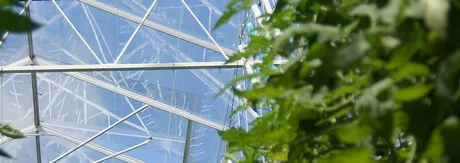On the way to fossil-free greenhouse horticulture, the availability of fossil CO2 is decreasing and (external) CO2 becomes a cost item. The first step to dealing with this is to see how CO2 can be used more efficiently. During the workshop of Peter Geelen at the EnergiekEvent on 11 April, a number of suggestions and approaches from Next Generation Growing were laid out.
Less ventilation losses
The most obvious step is to limit losses through the vents. This can easily be calculated by using the calculation tool.
Based on outside conditions of 700 watt / m2 irradiation, 18 °C, 60% RH, 400 ppm CO2, and in the greenhouse 20 °C, 70% RH and 600 ppm CO2 it turns out that 630 kg CO2 / ha.hr is discharged through the vents. By increasing the greenhouse temperature to 24 °C, the ventilation loss decreases to 250 kg / ha.hr. And if the RH also rises to 85%, the ventilation loss of CO2 is further reduced to 185 kg / ha.hr. This is due to the fact that the ventilation speed dropped from 170 to 68 and 50 m3 / m2.hr.
Decreasing the ventilation speed is easier with diffuse light, roof sprinkling and / or fogging. Fogging in particular is, according to Peter, a powerful tool in the future to operate with less CO2 input. "The ventilation losses can be reduced to zero by lowering the CO2 level in the greenhouse to the value outside. Depending on the irradiation, concessions will be made to an optimum plant growth."
Having the plant use CO2 more efficiently
First of all, of course the plant can handle CO2 more efficiently as the stomata are open better when exposed to irradiation. To achieve this, good irrigation is important. A constant plant balance ensures a constant root growth and prevents root necrosis, which means water stress. When high irradiation is accompanied by a sufficiently high air humidity, the crop can better handle the water balance so that the stomata remain open more and longer.
When more CO2 is available for the crop that subsequently can be absorbed better, this will result in more production of assimilates. To also convert this into more growth, the temperature, CO2 dependent, must be raised. Less airing therefore not only leads to less ventilation losses, but also to a more efficient use of CO2 by the crop.
This cultivation strategy with less ventilation can be further strengthened by growing with a ‘lower’ sink size, leading to a lower plant load in the form of fewer fruits, flowers or plants per m2, according to Peter.
CO2 dosage
Light-dependent CO2 dosing also increases the efficiency. The photosynthesis speed depends on the level of the irradiation. So the need for CO2 also depends on the amount of light. A control that makes the target value for ppm CO2 dependent on the irradiation (watts / m2) can be used for this. To optimize the availability of CO2 around the leaf, we can also think of sufficient air movement around the leaf and dosing CO2 in the head of the crop, Peter added.
With measures that limit ventilation losses, have the crop handle CO2 more efficiently and make the dosing method more effective, CO2 can be used more efficiently, according to Peter. "Then even less CO2 in cultivation goes together with better growth. No investments are needed for this and you can start with it today."
Source: Kas als Energiebron
